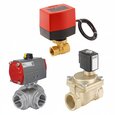Mechanical & Manual Actuated Pneumatic Valves
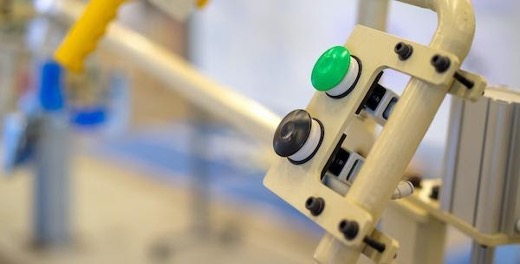
Figure 1: Button-operated pneumatic valve
Mechanical and manual actuated pneumatic valves regulate compressed air flow to connected components in pneumatic systems. They are referred to as directional control valves and are classified by two numbers such as 3/2-way, 5/2-way, and 5/3-way. The first number indicates the number of ports and the second number the states.
There are two types of pneumatic valves. Directional control valves and pneumatically actuated valves. The first is a device used to control airflow in a pneumatic system. The second is a device that uses compressed air to control the valve itself, while the media inside the system can be something else, such as a liquid or gas. This article covers the various types of mechanically and manually controlled pneumatic control valves.
Table of contents
- Pneumatic valve ports and states
- Roller operated pneumatic valves
- Button activated pneumatic valves
- Hand lever operated pneumatic valve
- Foot-operated pneumatic valves
- Pneumatic stem actuated valves
- Whisker operated pneumatic valve
View our online selection of mechanical & manual actuated pneumatic valves!
Pneumatic valve ports and states
Mechanical and manual actuated pneumatic valves commonly come in one of three different ports and states: 3/2-way, 5/2-way, and 5/3-way.
- 3/2-way: A 3/2-way valve has 3 ports (inlet, outlet, and exhaust) and 2 states (open or closed). It is used for a single-acting cylinder with a spring return, which requires a single action to extend. After the spring retracts the valve rod, the valve returns to its normal, non-actuated position. Learn more about 3/2-way valves.
- 5/2-way: A 5/2-way valve has 5 ports (inlet, 2 outlets, and 2 exhaust) and 2 states (outlet 1 or outlet 2 is connected to the input). They are used in applications that move continuously between two positions, such as extending and retracting double-acting cylinders, where it is not necessary to stop air pressure. Learn more about 5/2-way valves.
- 5/3-way: A 5/3-way valve has 5 ports (inlet, 2 outlets, and 2 exhaust) and 3 states (blocked center, open center, or pressure center). Blocked center indicates that all ports are blocked. The open center connects the outlets to their corresponding exhaust port. The pressure center connects the inlet to both outlets, allowing for two simultaneous actions, such as extending two cylinders at once to secure material between them. Learn more about pneumatic cylinders.
Roller-operated pneumatic valves
Automated systems use pneumatic roller lever valves to sense the position of parts mechanically. This happens when moving parts pass over the rollers, which, in turn, operates the valve. Since the wheel is able to rotate with the moving part, friction is reduced, which reduces the wear and tear of the pneumatic roller lever valve and the connecting component. They are commonly used to detect pneumatic cylinder strokes, door or barrier closures, or determine components' correct position before machine operation. There are several advantages to using this type of valve:
- The flexible nature of the pneumatic working ports provides a practical solution to a wide variety of needs
- Lightweight
- Minimal actuating forces
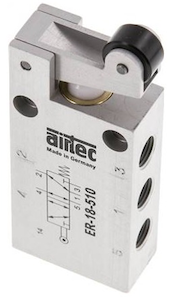
Figure 2: Roller-operated pneumatic valve
Button activated pneumatic valves
A pneumatic push-button valve signals other pneumatic devices in a system. They can be operated with various actuator types, such as a push-button, mushroom button, rotary switch, key switch, tumbler switch, or safety button. These button types each have their advantages:
- Push-button: This type of actuator can either be a latch button for continuous operations, a shrouded button for safety, or a push and hold button.
- Mushroom button: A mushroom button has a large contact area extending beyond the panel's surface, making it easy to operate with the palm. It is beneficial for repetitive processes when a robust button is needed.
- Rotary switch: This requires an operator to turn a switch to activate or de-activate the valve
- Key switch: This type is activated by turning a key.
- Tumbler switch: A simple actuator type, similar to a light switch.
- Safety button: Safety buttons are typically of the mushroom button type, which allows for quick activation.
Push buttons, safety buttons, and mushroom buttons often come with either a punch button with latch or a shrouded push button. Punch buttons latch, and a twist-action releases them from their hold position when pushed. A shrouded type push-button has a reduced contact surface, preventing accidental operation. The same is true of tumbler switches and key switches.
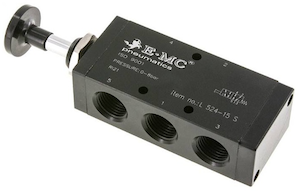
Figure 3: Button-activated pneumatic valve
Hand lever operated pneumatic valve
Pneumatic hand lever valves can be used to switch air supplies on and off manually. They are typically used to control cylinders within pneumatic systems or to signal other devices. There are several advantages to using this type of valve:
- User-friendly. The hand lever makes it easy for operators to operate.
- It can be used for a wide variety of pneumatic applications due to its small and compact size
- Metal or plastic housing ensures durability
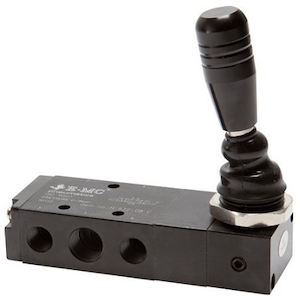
Figure 4: Hand-lever operated pneumatic valve
Foot-operated pneumatic valves
By using pneumatic foot pedal valves, the end-user can control other pneumatic devices in a system remotely; for example, they can operate pneumatic cylinders that hold workpieces in place for hands-free operation. Latching foot pedal pneumatic valves lock workpieces in place; re-applying pressure on the pedal releases the hold. Spring return versions perform repetitive functions such as dosing, pressing, punching, or drilling. When pressure is released from the pedal, the valve returns to its original position. The advantages of foot operated pneumatic valves are:
- Hands-free operation
- Available in heavy-duty full metal designs with floor mountings for use in areas where light weight designs would not survive.
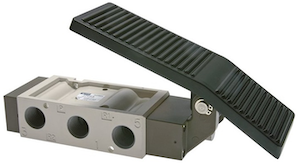
Figure 5: Foot-operated pneumatic valve
Pneumatic stem actuated valves
Pneumatic stem actuated valves, or plunger valves, are commonly used in machine automation systems to sense the position of moving parts. When a moving part pushes against the plunger, the valve is operated. The pneumatic stem actuated valve is often used for end of stroke travel for a cylinder as a limit switch for closing doors or barriers, or to verify the proper positioning of components before machine operation. Stem actuated valves have several advantages over other valves:
- The stem requires a minimum amount of travel to actuate, they are suitable for applications where a slight movement requires actuation.
- Small and lightweight
- Some designs can be used for vacuum applications
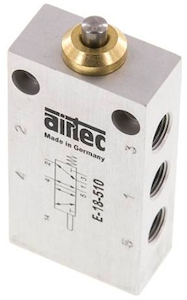
Figure 6: Stem-actuated pneumatic valve
Whisker operated pneumatic valves
Within machine automation systems, pneumatic whisker-actuated valves sense the movement of moving parts mechanically; a moving part touches the whisker, triggering the mechanism, and the valve opens.
The piloted valve with its extremely low actuating forces is especially suitable for systems with dissimilar parts or actuating elements without precision positioning or where the actuating levels vary. The whisker can be approached from any perpendicular direction to its axis. The advantages of the whisker-operated pneumatic valves are:
- Extremely low actuating forces, making these valves ideal for sensitive applications
- The whisker is easily replaced in case of damage
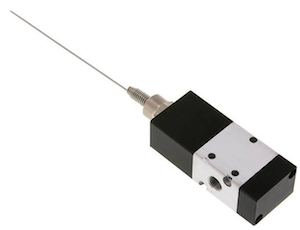
Figure 7: Whisker-actuated pneumatic valve










